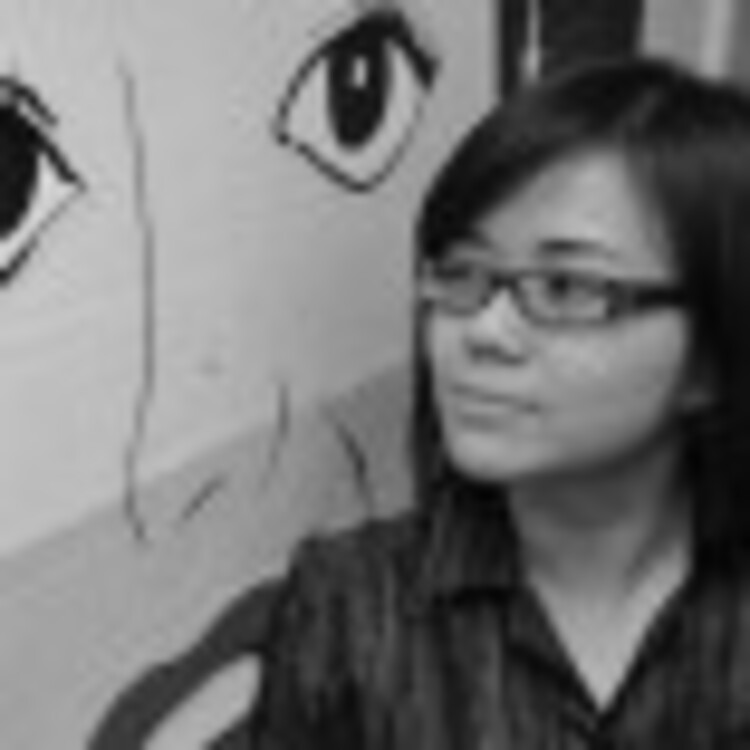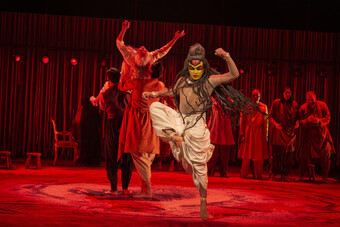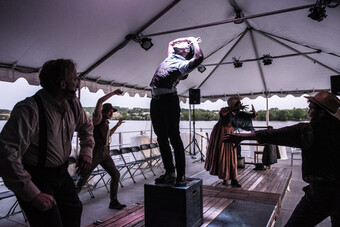Figuring the Fringe
Every year, under a combination of masochism and duress, I submit banished? productions’ application to the Capital Fringe. This application will fall somewhere in the middle of a mountain of creative and administrative work that has begun months ago and continues to unravel through meetings, studio sessions, crafting, repolishing, miscommunicating, and realigning. As soon as a project is conceived, all faculties are brought to bear and tested relentlessly as our small band of collaborators (which has included videographers, chefs, audio engineers, dancers, new media artists) bring the work from concept to being, using goodwill and time as a stand-in for monetary currency.
By the time I get ready to shell out the scarily expensive fees, with nothing more than a hope and a prayer that this year's show will break even, (we have not for the past two years) the collective haze of overwork usually hatches a fantasy among some of us for a simpler, more traditional show (with raunchy musical numbers thrown in for good measure). But “simple” simply isn’t part of the banished? vernacular. We wish we could but we never could do anything nice and easy.
banished?’s particular brand of experiential, hybrid-art, avant-pop work has taken shape in a glorious mess of mediums that stretch the definition of narrative and storytelling, ranging from sensory tactile dinners, to story-telling machines and alternative art audio-walks. The premise and aesthetic may sometimes be simple, but given the form, process, and the fact that we are inextricably drawn to the path of most resistance, we sometimes have to fabricate the effortlessness. With each passing year the projects we create get harder to define (is it theatre? Performance art? Audio art? A game? Our hybridity seems to equally frustrate and charm). The capacity per show has trended smaller, the planning and logistics more byzantine, and the demands on the audience's trust and willingness to play grow ever greater.
We’ve discovered that intriguing as the premises of our projects may sound, many Washingtonians hesitate when they can’t put a finger on the show. So while banished?’s fringe shows tend to generate buzz at Fringe, this buzz doesn’t necessarily generate ticket sales. We’ve pretty much lost potential audiences when they’ve heard there aren’t any seats, in fact, one that has them walking outside in an audio-play in merciless one-hundred degree weather, or did you see the other show that requires them to put what in their mouths for heaven sakes why?
But “simple” simply isn’t part of the banished? vernacular. We wish we could but we never could do anything nice and easy.
Sure, we’ve stacked the odds against ourselves, but how else can a group like ours launch experimental projects that challenge both ourselves and our audiences? The free-for-all feel of the festival brims with opportunity to sample and masticate rogue ideas and play to a hungry, willing audience that isn’t afraid to spew feedback. Anyone who’s toughed out a fringe will have, like us, learned to weather storms (quite literally with this year’s outdoor show despite the summer derechos). Meanwhile, we’ve sloughed off our intimidation of the press, become good listeners and better observers, and picked up other business skills beyond the art-making.

And so this is how Fringe has become banished?’s annual crash test, where unexpected successes and grand failures alike can be made apparent, and our art more honest. Our festival debuts have hardly been low-stakes, and we drive finished pieces straight into the wall of unknowns. We may be drained by the end of summer, but we’re buzzing with newfound knowledge for future iterations or incarnations (rarely ever “remounts”) that lie within the theatrical destiny of a project. Some successes have already been apparent: the launch of Tactile Dinner at Fringe in 2009 helped gear us up conceptually and build our audiences for two other Tactile Dinner shows staged in 2010, even giving birth to ideas that further push the concept with Tactile Dinner Car (a food truck version launched at the 2011 Fringe, then installed as a gallery exhibition later that fall) and the culturally translated Tactile Taste of Helsinki.
Other unbeknownst discoveries are also developing and have come only through being attentive to some tangible needs of our audience, another element that Fringe provides. For instance, how do you better ease an elderly audience member into a piece of technology that’s a necessary narrative and dramaturgical feature in your project? Answer: use less minuscule devices and spend time guiding them and listening to them afterwards.
As a producer, creator, and director, Fringe is to me what eating (mmm!) greens are to a (bacon-craving) vegetarian. The benefits to an artist’s creative process are undisputed, but for me, the desire to push further beyond a Washingtonian audience holds strong (although my addiction to creating work in DC may stem from an audience member’s feedback at our 2009 Fringe. A woman came up to me to thank me for the show, and as she squeezed my arm, said, “You realize you just made a roomful of strangers—Washingtonians mind you—physically touch each other?” I think a part of me will not rest until this stereotypical Washingtonian becomes a thing of the past and rediscovers playing for play’s sake).
With my current work in Helsinki, Finland, and in Europe (where my love for hybrid theatre was born over a decade ago) I have been trying to suss out the cultural and production nuances so critical in adapting our original pieces, while keeping a pulse on current interdisciplinary work in music, dance, performance, and design that resonates with our aesthetic. Perhaps in this breaking down and development of smaller working parts of a project, my company will finally find that the success we’ve found at Fringe and increasingly elsewhere is not a fluke. Perhaps at the end of this journey is a juicy satisfying formula (accompanied by a nice chunk of change) to grow shows that we could tour to other festivals. But until then, we’ll be pulling teeth and gnashing hair, and submitting yet another Fringe application for 2013.















Comments
The article is just the start of the conversation—we want to know what you think about this subject, too! HowlRound is a space for knowledge-sharing, and we welcome spirited, thoughtful, and on-topic dialogue. Find our full comments policy here